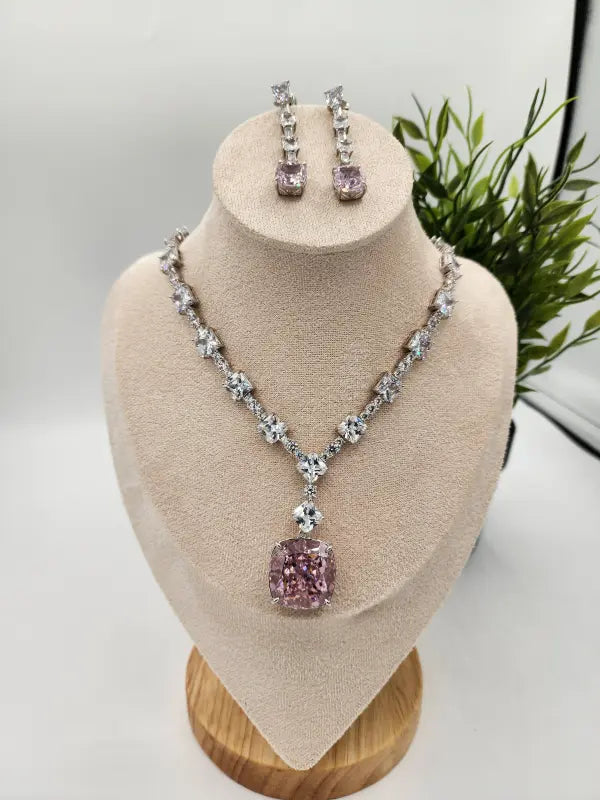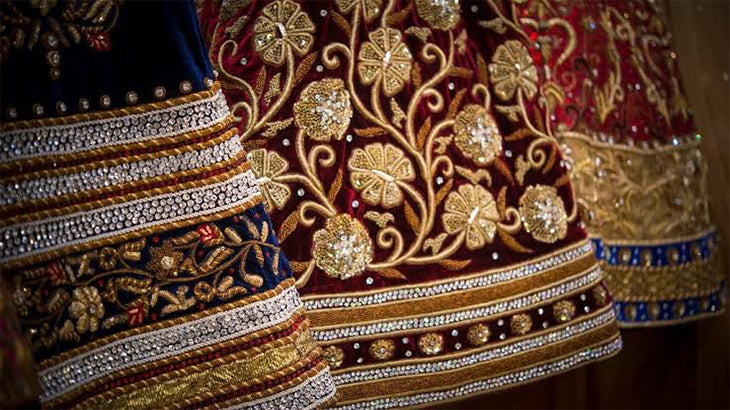Zari Zardozi is a prestigious form of embroidery with Persian origins, renowned for its use of metallic threads to create intricate and elegant designs. This traditional craft, rich in history and cultural significance, has been embraced and celebrated across various regions of India, particularly in Madhya Pradesh. In this comprehensive exploration, we delve into the origins, historical journey, design elements, and contemporary status of Zari Zardozi, highlighting its enduring legacy and ongoing revival.
Origins and Historical Significance
Zari Zardozi, a term that translates to "embroidering with gold threads," traces its roots back to Persia over 300 years ago. This opulent embroidery technique gained prominence during the Mughal era in India, thanks to the patronage of Emperor Akbar in the 17th century. Under his reign, the craft flourished, blending Persian artistry with Indian sensibilities.
However, the craft faced a significant decline during the rule of Aurangzeb. The lack of royal patronage and the high cost of raw materials, which were scarce at the time, hindered the artisans' ability to meet demand. This decline led many artisans to migrate from Delhi to states like Madhya Pradesh, Rajasthan, and Punjab in search of new opportunities.
The industrialization of the 18th and 19th centuries further impacted the craft's popularity. The onset of mechanization and mass production led to a decrease in the traditional handcrafted methods. It wasn't until India gained independence in 1947 that efforts were made to revive and support various traditional handicrafts, including Zari Zardozi.
Revival Efforts and Royal Patronage
The revival of Zari Zardozi in the post-independence era can be attributed to the efforts of Bhopal's Begums. They played a crucial role in preserving and promoting this ancient embroidery. By educating the local population about the craft and encouraging its practice, the Begums ensured that Zari Zardozi continued to thrive.
The Begums themselves utilized Zari Zardozi in their personal accessories, such as 'batuas'—small purses used to carry cash and other essentials. They also commissioned garments for the royal court and affluent individuals, showcasing the craft's opulence on luxurious fabrics.
Craftsmanship and Design Elements
Zari Zardozi embroidery involves intricate techniques that use gold and silver metallic threads to create stunning designs. The core technique remains consistent across different Indian states, with variations primarily in the design patterns.
Traditional designs often feature motifs inspired by Mughal art, including floral patterns, leaves, panchi (birds), and paan (betel leaves). These motifs, characterized by their intricate detailing and rich texture, were popularized during the Mughal era and continue to be cherished.
In contemporary times, Zari Zardozi has evolved to incorporate geometric and abstract interpretations of traditional motifs. This adaptation ensures that the craft remains relevant and appealing to modern audiences while preserving its historical essence.
The Crafting Process of Zari Zardozi
The making of Zari Zardozi involves a meticulous and intricate process that combines traditional embroidery techniques with high-quality materials. This process, which has been refined over centuries, involves several key steps to achieve the luxurious and detailed designs characteristic of Zari Zardozi.
1. Selecting Materials
The first step in creating Zari Zardozi embroidery is choosing the right materials. The primary components include:
- Fabrics: Luxurious fabrics such as silk, velvet, organza, and chiffon are commonly used. These fabrics provide a rich base that enhances the sheen and intricacy of the metallic threads.
- Metallic Threads: Zari Zardozi employs gold and silver metallic threads, which are often made from thin strips of metal or coated with metallic pigments. These threads are crucial for creating the craft's distinctive shimmer and elegance.
2. Preparing the Fabric
Before the embroidery begins, the fabric needs to be prepared:
- Washing and Dyeing: The fabric is washed to remove any impurities and dyed to achieve the desired color. This step ensures that the fabric is clean and ready for the embroidery process.
- Stretching and Sizing: The fabric is stretched onto a frame or hoop to keep it taut. Sizing may be applied to stiffen the fabric slightly, making it easier to work with.
3. Designing the Pattern
The next step involves creating and transferring the design onto the fabric:
- Design Creation: Traditional motifs, such as flowers, leaves, and geometric patterns, are either drawn by hand or printed as templates. Contemporary designs might include abstract or modern interpretations of these traditional motifs.
- Tracing the Design: The design is traced onto the fabric using chalk or a fabric marker. This outline serves as a guide for the embroidery process.
4. Embroidering the Design
The actual embroidery process is where Zari Zardozi truly comes to life:
- Threading the Needle: The metallic threads are carefully threaded into needles. Due to their delicate nature, special care is taken to prevent fraying or breaking.
- Stitching Techniques: Various stitches are employed, including:
- Zardozi Stitch: This is a specific stitch where metallic threads are used to outline and fill in the design. It often involves intricate and overlapping stitching.
- Kundun: A technique where the metallic threads are used to create raised patterns on the fabric.
- Aari Stitch: This involves using a hooked needle to create chain stitches with the metallic threads.
- Detailing: Additional embellishments, such as beads, sequins, or pearls, might be added to enhance the design's richness and texture. These are carefully sewn onto the fabric as part of the final touches.
5. Finishing Touches
Once the embroidery is complete, the fabric undergoes several finishing processes:
- Trimming and Cleaning: Excess threads and any residual chalk marks are trimmed and cleaned. The fabric may be gently pressed to remove wrinkles and enhance the overall appearance.
- Final Inspection: A thorough inspection is carried out to ensure the quality of the embroidery. Any imperfections are corrected, and the final product is prepared for sale or use.
6. Creating the End Product
The embroidered fabric is then used to create various end products, such as garments, accessories, or home decor items:
- Garments: The embroidered fabric is cut and sewn into traditional garments like sarees, lehengas, or kurtas.
- Accessories: Items like purses, clutches, and decorative pieces are crafted from the fabric.
- Home Decor: Embroidered fabrics can also be used for cushion covers, curtains, and table runners.
How to Care for Zari Zardozi Embroidery
Zari Zardozi embroidery, with its intricate patterns and luxurious metallic threads, requires special care to maintain its beauty and longevity. Here are some essential tips for preserving this exquisite craft:
1. Gentle Washing
- Hand Wash: It is best to hand wash Zari Zardozi items to avoid damage. Use lukewarm water and a mild detergent. Avoid soaking the fabric for too long.
- Spot Cleaning: For small stains, gently dab the area with a soft cloth or sponge soaked in a mild detergent solution. Avoid rubbing vigorously.
2. Drying and Ironing
- Air Dry: After washing, gently squeeze out excess water without wringing the fabric. Lay it flat on a clean towel to air dry, away from direct sunlight or heat sources.
- Ironing: Iron the fabric on the reverse side using a low heat setting. Place a thin cloth between the iron and the embroidery to prevent direct contact with the metallic threads. Avoid using steam, as it can damage the threads.
3. Storage
- Avoid Direct Sunlight: Store Zari Zardozi items in a cool, dry place away from direct sunlight to prevent fading and deterioration of the metallic threads.
- Use Acid-Free Paper: For long-term storage, wrap the fabric in acid-free tissue paper or place it in a breathable fabric bag. Avoid plastic bags as they can trap moisture and lead to mildew.
- Avoid Heavy Folding: Store the items flat or roll them gently with acid-free tissue paper in between folds to avoid creasing and pressure on the embroidery.
4. Handling
- Minimize Contact: Handle Zari Zardozi items with clean, dry hands to avoid transferring oils or dirt to the fabric. When wearing or using embroidered items, be mindful of potential snags or pulls.
- Avoid Chemicals: Keep Zari Zardozi away from harsh chemicals, perfumes, or sprays, as these can tarnish the metallic threads and damage the fabric.
5. Professional Cleaning
- Consult Experts: For heavily soiled or delicate items, it is advisable to seek professional cleaning services specializing in embroidery or delicate fabrics. They have the expertise and appropriate methods to clean and restore Zari Zardozi items without causing damage.
6. Regular Maintenance
- Inspect Regularly: Periodically check the embroidery for any loose threads or damage. Address any issues promptly to prevent further deterioration.
- Repairing: If any threads become loose or damaged, consult a skilled artisan for repairs to restore the item's original beauty.
Challenges and Contemporary Status
Despite its timeless appeal, Zari Zardozi faces several challenges in the modern era. The embroidery process is highly labor-intensive and time-consuming. Completing a single set of fabric—approximately 800 meters—can take over a month. Skilled artisans, who often have years of experience, are required to execute the intricate designs.
The process involves multiple stages, including washing, dyeing, and printing, which further add to the craft's complexity. This demanding nature of the craft has led to a decline in its practice, as many artisans struggle to meet the rigorous demands of the traditional methods.
To address these challenges, there is a growing effort to train new artisans in more time-efficient techniques. By adopting modern printing methods that maintain the essence of Zari Zardozi while reducing production time, artisans hope to sustain the craft's relevance and meet contemporary market demands.
The Revival and Future of Zari Zardozi
Today, the number of artisans and boutiques specializing in authentic Zari Zardozi is limited. However, there is a concerted effort within the community to revive and sustain this cherished craft. Families of traditional Nandna printers and other artisans are working tirelessly to reintegrate Zari Zardozi into the market.
This revival involves not only preserving traditional techniques but also adapting them to contemporary tastes and trends. The goal is to create a space in the market for Zari Zardozi, ensuring that future generations can continue to appreciate and support this beautiful form of embroidery.
Conclusion
Zari Zardozi stands as a testament to the rich cultural heritage and artistic brilliance of the regions where it is practiced. Its journey from Persian origins to Mughal grandeur, through periods of decline and revival, reflects the resilience and adaptability of this timeless craft.
As artisans continue to innovate and revive Zari Zardozi, the craft's legacy is poised for a resurgence. With ongoing efforts to balance traditional techniques with modern demands, Zari Zardozi is set to maintain its status as an exquisite form of embroidery that captivates and adorns with elegance and grace.
FAQs
1. What is Zari Zardozi?
Zari Zardozi is a traditional embroidery technique from Persia, known for using gold and silver metallic threads to create intricate and elegant designs on luxurious fabrics.
- How should Zari Zardozi items be washed?
Hand wash Zari Zardozi items using lukewarm water and a mild detergent. Avoid soaking for long periods and spot clean small stains gently.
- Can I iron Zari Zardozi fabric?
Yes, but iron on the reverse side using a low heat setting. Place a thin cloth between the iron and the embroidery to protect the metallic threads and avoid using steam.
- How should I store Zari Zardozi items?
Store items in a cool, dry place away from direct sunlight. Use acid-free paper or a breathable fabric bag, and avoid plastic bags to prevent moisture buildup.
- When should I seek professional cleaning for Zari Zardozi?
Consult professional cleaners specializing in delicate fabrics for heavily soiled or delicate Zari Zardozi items to ensure proper care and restoration.




